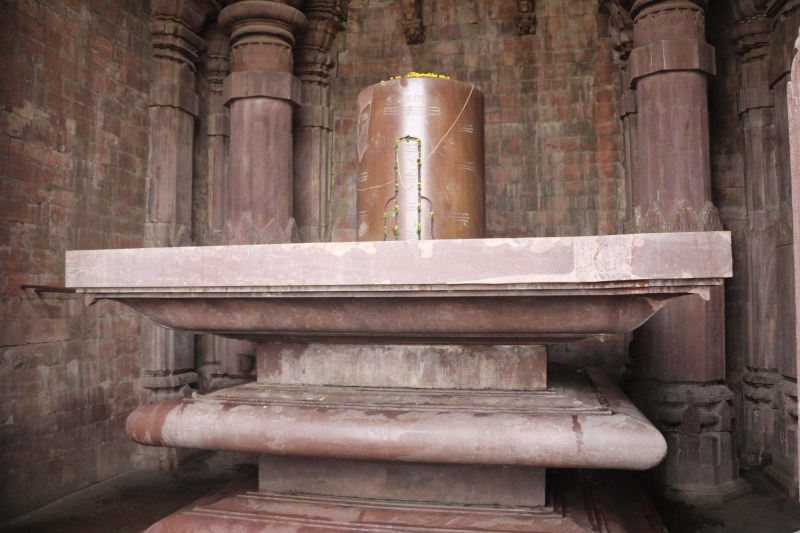
This is the world’s largest Shiva-linga… several tonnes in weight and about 22 feet in height according to the ASI measurements. Let us visit today the Bhojeshwar temple of Bhojpur … a town that lies about 40km southeast of Bhopal. It is simple but magnificent, minimalist but enigmatic. Let us go back about a thousand years to mid 11th century to know more about this abode of Shiva.

Kaliasot – a tributary of Betwa river
I love such trips … only one day trip to Bhopal … but fieldwork was to be conducted on the rural periphery of the city of lakes and I had an hour or two in golden sunlight in the locality. We were close to the Kaliasot river … a tributary of river Betwa … known as Betrawati in the ancient times. Before we get into the history and archaeological details of the Bhojeshwar temple let’s have a cup of tea and find out what the locals say. According to the mythology locally prevalent … this temple was built by the Pandavas during their exile away from Hastinapur. Some also believe that Kunti left the infant Karna somewhere here on the banks of Betwa river.
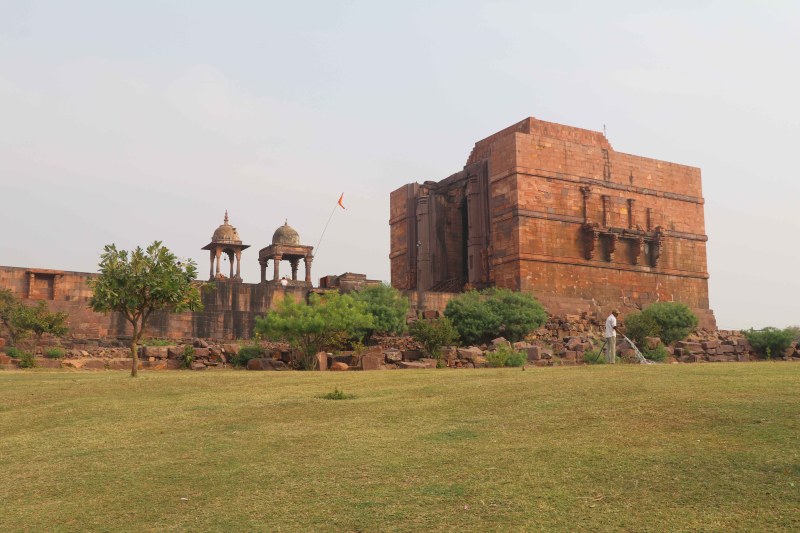
According to reliable historic data … This temple was built in the early-mid 11th century by Parmara king Raja Bhojadeva (1010-1055CE) while the temple is grand in scale but it is an incomplete monument… Why the construction was not complete is not clear. There was no inscription found in the temple because perhaps it was never completed.. but other inscriptions related to Bhojadeva of Paramara clan confirm that he was the ruler of this region while the Bhojeshwar temple was being constructed. Bhoja was a great patron of art and architecture and writer of 11 scholarly books. Samarangana Sutradhara being one of the finest works on Indian architecture with 83 elaborate chapters. This tells us something about an interesting phenomenon found here … which we will talk in detail about towards the end of this blog.



This massive temple is built on a platform that is 106 feet long, 77 feet wide and 17 ft in height. The incomplete sanctum sanctorum or the Garbhagriha is supported by 4 almost 40 feet tall colossal pillars and about 12 pilasters.
We can see figures of Ganga and Jamuna on both sides of the entrance and some more sculptures on the panels … which are not labelled and I could not find out more about those. There is a wooden platform and staircase made … it hides some interesting figures – like the elephant being attacked by perhaps a tiger or lion.




Barring the facade all other walls are bereft of any ornamentation… There are balconies on the remaining three faces which do not have any functional purpose. According to ASI researchers, these balconies were perhaps used to display the deities of the Paramara family.
There are several interesting figures and sculptures in the column capitals, inner walls and outer walls … but the ASI board says precious little about these … There is a note which says that the temple has Uma-Mahesha, Lakshmi-Narayana and Bramha-Savitri figures … but nothing specific that helped me identify these sculptures. I hope experts will help me label some of the photographs I am sharing here …



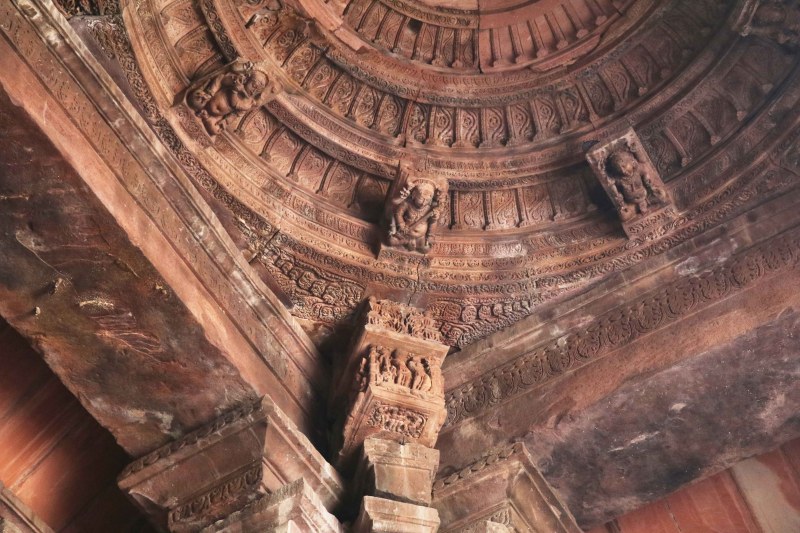


Gandharvas perhaps?
While the external walls of this temple are simple the roof is intricately carved and has beautiful sculptures. I hope ASI puts together an infographic/ visual map for us to help us appreciate these monuments better.



One always feels fascinated behind the science and engineering employed to build these monuments. How did the craftsmen carry such huge boulders to such heights? What kind of crane or mechanical assembly was used to execute this? We have a clue here because this is an incomplete site.
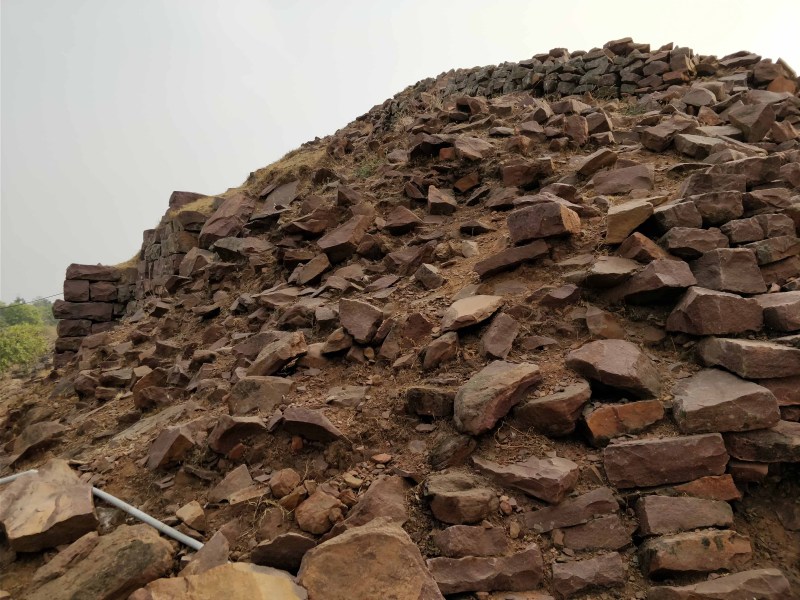
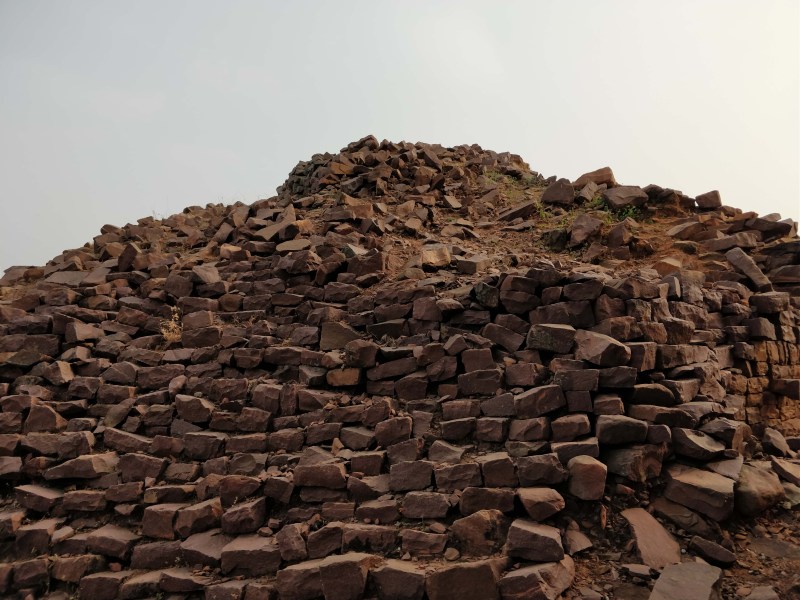

Ramp
A large stone ramp was built here that was extended towards the base of Shikhara and perhaps these huge stones were dragged up using ropes or with help from carts pulled by animals. We can see the remnants of this ramp here behind the temple.

According to ASI records – large stones like 35x5x5 feet and weighing 70 ton were lifted to Shikhara using this ramp. If we look at the satellite image, the ramp is perhaps better visualized.




With a patron king like Bhoja deva – who was an astute scholar of Indian architecture it is interesting that we have several rocks with detailed plans and elevations of temple architecture carved. Some were perhaps for illustrative purpose and some engravings had a votive or ritual importance.



Cyclopean dam at Bhojpur
Another important feature that must be explored here is the walls of the cyclopean dam built on Betwa river. The dam was built in the same period i.e. 1010-1055 CE and has attractive stone walls. There is no binding agent like mortar seen here between the rocks piled up… but structurally walls have remained strong.

There is a small museum at Bhojpur but unfortunately it was closed for repairs when I visited…. it was sad to see several relics kept uncared out in the open…Coming up next is Bhimbetka – the world heritage site famous for cave paintings.
References –
- ASI
- MP tourism
- Elements of Indian Art – GP Gupta





